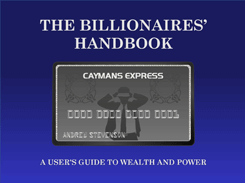
 |
The Billionaires' Handbook: A User’s Guide to Wealth and Power
by Andrew Stevenson
Stevenson’s handbook simplifies economic complexities through visual storytelling. Though there are short snippets of written guidance, the tongue-and-cheek humor of the illustrations is at the forefront. More than anything else, Stevenson takes intricate topics like mercantilism and capitalism and packages them with the entertainment and ease-of-readability of a children’s book.
From the get-go, it is clear that the billionaire club is all about rules—creating them in particular. The opening sets of rules, structured like a graphic novel, are particularly intriguing as they personify the rise and demise of the pillars of our global economy over the last half millennia: feudalism, mercantilism, capitalism, and, finally, the present era of cynicism.
Where this handbook specifically excels is in taking dry concepts like absentee citizenship, rising output, and supply and demand and injecting enough humor to engage and interest the reader. For instance, the image of billionaires being welcomed to Taxhavia is hilarious and provides a picture-perfect understanding of absentee citizenship. Rules that stand out include “Rule 1” in the new rules where a Matrix-style battle against taxes is coupled with phrases like “Remember, it’s not cheating if you make it legal” and “Rule 7” where distractions and media are depicted through a man seemingly doing Pilates on a split Twinkie.
Although some of the rules, ironically represented by blindfolded characters in the illustrations, are eye-opening and somewhat contentious, the good-natured humor and intent to deliver information is genuine. Beneath the layers of humor and personification lies sound advice such as allocating college tuition money in a retirement account, being environmentally conscious, and being wary of artificial intelligence. True to form, this handbook is a magnet for accruing wealth and power. It is both humorous and informative and likely to be appreciated by those with a particularly competitive mindset and drive.